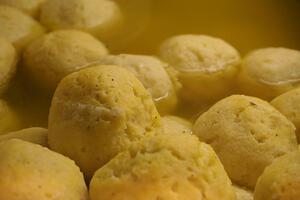Floaters or Sinkers?
In the degradation of Passover tradition that happens when parents get older and children move away; at times when there is no one young enough to sing the Four Questions without embarrassment; when the eating of the Hillel Sandwich is skipped because everyone at the table gets acid reflux; when the traditional four cups of sock-rotting Manischewitz dwindles to a single glass of Hagafen Chardonnay that is raised four times and demurely sipped by the host alone, one Passover tradition lives on: Matzoh balls, or knaidlach. Or, as my neighbor calls them, “those cool things you Jewish people put in soup on Passover.”
The matzoh, (or matzah, or matza, or matzo) ball is a universal tradition among all Ashkenazic families I know, and some Sephardic ones, too. The essential characteristics of the matzoh ball are: approximately round in shape, whitish in color (except when chopped parsley or dill is added), cooked in liquid, and served in soup. In most cases, it is cut and eaten with a spoon. Every other characteristic is dependent on the matzoh ball maker and a host of factors such as humidity, recipe, custom, and dietary restrictions (such as salt and cholesterol intake). Did you know that Adam Sandler has a dog named Matzaball? A nice Jewish boy, Adam Sandler, but I wonder what his mother’s matzoh balls looked like, that he named his British bulldog after one.
Perhaps Adam’s family went to Spiegel’s restaurant near Yankee Stadium when he was a child, as mine did. At Spiegel’s, you got ONE giant matzoh ball, about the size of a softball, when you ordered “chicken soup with matza ball.” That matzoh ball sat dry in the soup plate nestled next to a metal cup of soup until the waiter poured the soup from the cup into the bowl at your table. This must have had something to do with the layout of the restaurant — Spiegel’s had levels and steps, not a good thing for carrying a full plate of soup around. Restaurant matzoh balls always seem to be on the large side.
Homemade matzoh balls, however, tend to be about the size of ping-pong or golf balls, sometimes with finger marks, sometimes rolled to a perfectly symmetrical roundness. My mother’s matzoh balls were perfectly round and smooth. You could have played bocce or handball with them. You needed a knife, they were so dense. Classical “sinkers,” they could have been used to weight a fishing line. I approached them as if they were starchy jawbreakers, first rolling them around in my mouth to remove the smooth outer coating, then slowly reducing their diameter until they became small enough to chew for a while and swallow.
Such matzoh balls were a fabulous prelude to a family sleepover, because with a couple of those in your stomach, sharing a bed with your cousins who were sleeping over was easy. You lay down and woke up in just the same place on the bed. Nobody changed position during the night. These Russian matzoh balls, developed in the Pale of Settlement, had been passed down to my mother from her mother, were an evolutionary adaptation to shtetl and Depression life, where everyone shared a bed.
Aunt Laurie, my mother’s youngest sister, was born in 1940, after the Depression, and she got to sleep in her own bed, which may be why HER matzoh balls were “floaters,” light and fluffy creations you could cut with your spoon. Aunt Laurie made both Seders for the family for 50 years, partly because she was the first one among her siblings to own a home, and because she was married to Uncle Mickey the Rabbi. Anyway, Aunt Laurie made great matzoh balls. Her secret was to follow the recipe on the box from Horowitz-Margareten except she would use club soda instead of regular water, and let the batter rest in the fridge for a half an hour.
Since I starting making matzoh balls myself in 1987, I have discovered that the difference between floaters and sinkers is how much air and water the batter contains. You can get extra air into batter by using club soda instead of water, or by separating your eggs and whipping the whites separately. Letting matzoh ball batter stay longer in the fridge will generate a softer matzoh ball, more likely to float, because the matzoh meal takes up more water. I have made matzoh balls without chicken fat. I have made low-cholesterol, egg-whites-only matzoh balls. Low-salt is very easy. One thing you can’t leave out, though, is some form of protein to bind the batter. Leave out the egg, and you will only get gook.
If you are being germophobic use two teaspoons. For speed, a cookie dough scoop dipped in water works well. For perfectly round matzoh balls, you have to form them with your own two (wet or oily) hands.
Here are two recipes: The first one, for “sinkers,” is from Claudia Roden’s excellent cookbook, The Book of Jewish Food and one for “floaters,” from Zell Shulman’s, Something Different for Passover.
For Dense Matzoh Balls:
1 egg
1 Tb melted chicken fat
2 Tb warm water
¼ tsp salt
dash white pepper
½ cup matzoh meal
Beat 1 egg, then add 1 heaping tablespoon of melted chicken fat, 2 tablespoons of warm water, salt, white pepper, and ½ cup (75 grams) of matzoh meal. Immediately form into ¾ inch balls with oily hands and drop into slowly boiling salted water. Cook in boiling water for 20 minutes. Drop into hot soup, boil 15 minutes and serve. Or use as artillery.
For Light Matzoh Balls:
3 large eggs, separated
½ teaspoon salt
Dash of white pepper
¼ teaspoon cinnamon
¾ cup matzoh meal
Combine egg yolks with salt, pepper, and cinnamon in a medium bowl. In another bowl beat egg whites until stiff but not dry. Fold the whites slowly into the egg yolk mixture with a rubber spatula. Slowly fold in the matzoh meal, ¼ cup at a time. You may not need the entire ¾ cup; it depends on the size of the yolks. The batter should absorb the matza meal but still hold air and the batter should not become thick like paste. Cover and refrigerate batter. Bring a 4-quart pot of water to a boil, then remove the matzoh-ball mixture from the refrigerator. Moisten your hands with cold water and form balls, dropping them into the boiling water. Cover the pot, lower the heat to simmer, and cook for about 20 minutes, Remove the matzoh balls with a slotted spoon. When cool, add them to the chicken soup and simmer for 15 minutes before serving. The matzoh balls can be made several days ahead and stored in the refrigerator before dropping in hot soup. They may by used in any type of broth, or served hot as a substitute for potatoes.
Happy Passover, everyone!
Preeva Tramiel is a freelance writer in Palo Alto, California. She blogs at Melon Memories.








My family scream out hard balls and raise their hands. Some like soft fluffy ones. I think those are the easiest. I need to make 25 dense balls. Please tell me how
My mom's were sinkers. Directly out of her first cookbook, The Jewish Home Beautiful. Pinch of nutmeg, like almost all of the recipes in that book for some reason. But she would sift through the matza meal to make sure she only got the whitest of white grains! Memories...
I had a great chuckle over the idea of "sinkers" having survival benefits. Thanks for making them seem a bit more palatable!